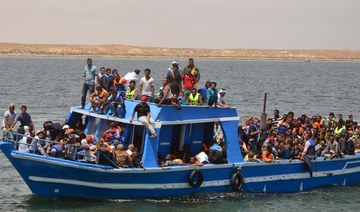TUNIS: Top Italian and European Union officials are holding talks in Tunisia on Monday to try to stem the growing numbers of migrants crossing from the North African country to Europe.
Tunisia's president, whose young democracy is struggling economically, said he wants the talks to focus not only on security measures to curb migration but also on broader European aid to fight the poverty and joblessness that fuels it.
The number of migrants leaving Tunisia has grown as much as fivefold this year compared to last year, for a total of about 5,700 people, according to estimates from the Tunisian Forum of Economic and Social Rights, an aid group following migration flows.
More migrants landing in Italy now came from Tunisia than departed from neighboring lawless Libya, according to Italian government figures released Saturday. A total of 16,347 migrants reached Italian shores over the past year, a 149 percent increase compared to the previous 12-month period, but still a number much lower than in several other recent years.
Italian Interior Minister Luciana Lamorgese, Foreign Minister Luigi Di Maio, EU Home Affairs Commissioner Ylva Johansson and the EU's commissioner for neighboring countries Oliver Varhelyi were scheduled to meet Monday with Tunisian President Kais Saied and other top Tunisian officials.
Lamorgese, who visited Tunisia just two weeks ago for similar talks, said the trip is aimed at boosting Europe-wide solidarity with Tunisia.
Tunisia's leader said he wants to broaden the migration discussion with Italy to make it more European, according to the official news agency TAP.
“Now is the time to act together to contain the (migratory) pressure and tackle the root causes ... to help change the perception of young people of their reality and of their country and give them hope for a better life in their own country, rather than venturing into an unknown future," Saied said in a statement.
HIGHLIGHTS
• The number of migrants leaving Tunisia has grown as much as fivefold this year compared to last year, for a total of about 5,700 people.
• Tunisia’s unemployment rate stood at 15 percent before the coronavirus pandemic and has since climbed to 21 percent.
Tunisia’s unemployment rate stood at 15 percent before the coronavirus pandemic and has since climbed to 21 percent. The country has struggled to restore prosperity since protesters overthrew a longtime autocrat in 2011, unleashing Arab Spring uprisings around the world.
The Italian and EU delegation is also expected to visit the Bardo Museum in Tunis, to honor victims of a 2015 extremist attack there that killed 21 people of various nationalities. The attack on one of the country's prime tourist sites damaged Tunisia's tourism industry.
Meanwhile in North Macedonia, a major transit point for migrants entering the EU, police said Monday a car carrying a dozen migrants from Syria crashed into a stationary police truck, killing two of the car passengers and injuring the other 10 as well as a police officer.
Police said the accident occurred Sunday night near the town of Radovis, about 100 kilometers (63 miles) southeast of the capital Skopje.
The Greek border with North Macedonia was closed earlier this year due to the coronavirus pandemic. But trafficking networks remain active, ferrying migrants who make their way from Turkey into Greece and then attempt to head north to more prosperous European countries.
Police said that in July alone they had detained a total of 567 migrants attempting to illegally transit North Macedonia.





























